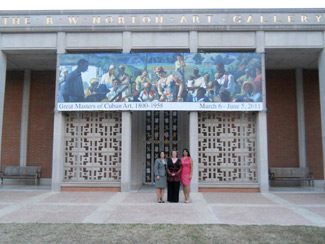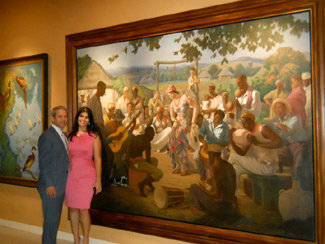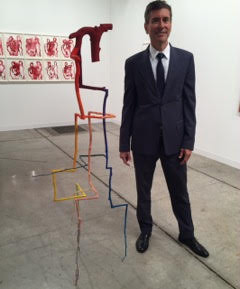Art Miami
Tony Japour Brings us a Taste of Cuba


Anthony Japour (AJ) is an independent curator, private art dealer and owner of AJ Japour Gallery. The gallery deals in contemporary art with a focus on the Chinese Contemporary Art Movement and its relationship to the pillars of Western Contemporary Art. Since 2003, AJ has produced numerous art exhibitions and installations in Miami and South Florida. In addition, the Gallery’s secondary mission is to support organizations dedicated to the health, education, and welfare of children. AJ has served on the Fine Arts Board and the Cultural Arts Council of the City of Miami Beach.
Preamble
Tucked away in Little Havana is jewel known as CubaOcho Art and Research Center. Having discovered this gallery about a two years ago, I was curious to find out more about the gallery and had a great opportunity to hear about the Ramos Collection from his wife and Executive Director, Yeney Fariñas Ramos.
GREAT MASTERS OF CUBAN ART – THE RAMOS COLLECTION
CubaOcho- Art & Research Center
1465 S.W. 8th St.
Miami, FL 33135
cubaocho.com
R.W. Norton Art Foundation
4747 Creswell Avenue
Shreveport, LA 71106-1899
www.rwnaf.org

On the feast of the Epiphany in 1992 in what would make a great epic film, gallerist and private art dealer Roberto Ramos and his brother Carlos took a small wooden boat built in 1956 and set sail for America fleeing Fidel Castro’s communist Cuba. Hidden away like a stowaway was a small Carlos Sobrino painting El Saxofonista (The Saxaphone Player), 1953 given to the young men in 1982 in return for helping an elderly man move. The elderly man had regularly lent books published during the Cuban Republic (1902-1958) and told Ramos and his brother that Sobrino was a “famous” artist. Appealing to his entrepreneurial spirit Ramos began to search for the artist in the Cuban National Museum of Fine Arts but could find no mention of Sobrino. With persistence, the brothers found themselves in the José Martí National Library and found out why Sobrino’s work could not be found in the museum. Apparently the artist left Cuba in exile and despite having won the National Prize for Painting in 1959, was persona non-grata and all marks of his artistic output were erased from Cuban society. With this finding, Roberto Ramos began his passion to collect works from artists depicting Cuba between 1800-1958 now the subject of a grand exhibition on view at the Norton Art Foundation museum in Shreveport, Louisiana.
Figuring prominently in the Norton Art Foundation museum exhibition is a work by Esteban Valderrama y Peña which commemorates one of the most important medical scientific discoveries of the twentieth century made by a Cuban doctor. Dr. Carlos J. Finlay (1833-1915) in 1881 demonstrated that the A. aegypti mosquito was the transmitting vector of a viral disease known as Yellow Fever rather than human-to-human contact. Yellow fever was the first virus shown to be transmitted by mosquitoes. Yellow Fever was eradicated from Havana and later in Central America which led to the successful effort to build the Panama Canal after previous attempts by the French were in vain due to high mortality rates from the disease. Using archetypical colonial elements, the painting, El trifuno de Finlay (Finlay’s Triumph) 1944, depicts Dr. Finlay explaining his hypothesis to members of the United States Army Yellow Fever Commission, including Dr. Walter Reed, after which the Walter Reed Army Institute is named. Ramos acquired the painting from a Spaniard who had worked in the Cuban Presidential Palace in 1959 and was ordered to remove and destroy the painting by Fidel Castro’s administration as it included Americans during a period of military occupation in 1901. Instead, the Spaniard escaped to Spain where he hid the painting until selling it to Roberto Ramos who subsequently had the painting restored.

Everyday life painting was the rage in the years of the republic and artist Oscar Garcia Rivera y Gutiérrez (1914-71) is well known for this colorful oil on canvases such as La Universidad (The University), 1954. One of his most beautiful canvases is a realist portrait Silvia, 1940 of his wife Silvia Fernández Arrojo (also an artist, see below) subsequently displayed in the United States National Museum in Washington, D.C. in 1947. While Garcia Rivera continued to paint after 1959 including such scenes from the Bay of Pigs, his works were considered unacceptable by the new government and censored. The artist found himself sentenced to forced labor while his and Silvia’s works disappeared from Cuba’s museums.
Silvia Fernández Arrojo (1918-1981) was a brilliant painter in her own right and appointed by her mentor Leopolodo Romañch Guillén as Assistant Chair of the Colorist Department at the prestigious San Alejandro Academy. Later, after his death, she became the Chair of the department. The Ramos’ have conducted a thorough research examination in the art of Fernández Arrojo and her husband Garcia Rivera finding the importance of their works at the end of the Cuban Republic in 1958. The CubaOcho Research Center contains many of the original documents and critiques of Fernández Arrojo’s works that were purchased from the artist’s sister. In Tras el cristal (Behing the Glass), 1947, the artist who was a portraitist, conveys the emotional thrill, excitement, and wistfulness, of three children looking into a storefront toyshop.
CubaOcho Art and Research Center is devoted to the promotion of the Cuban cultural arts, not only in the visual fine arts but also in music, dance, and readings.

Anthony Japour is an art collector and art advisor. Japour lectures on the Chinese Contemporary Art Movement and its relationship to the pillars of Western Contemporary Art. For over a decade [2002-2012], Japour mounted numerous art exhibitions and installations in Miami Beach and South Florida through AJ Japour Gallery and linked these exhibitions to charity events at his home in South Beach devoted to the health, education and welfare of children. Japour has served on the Fine Arts Board and the Cultural Arts Council of the City of Miami Beach. Japour has been a contributor writing on contemporary art for SocialMiami.com since 2010.


